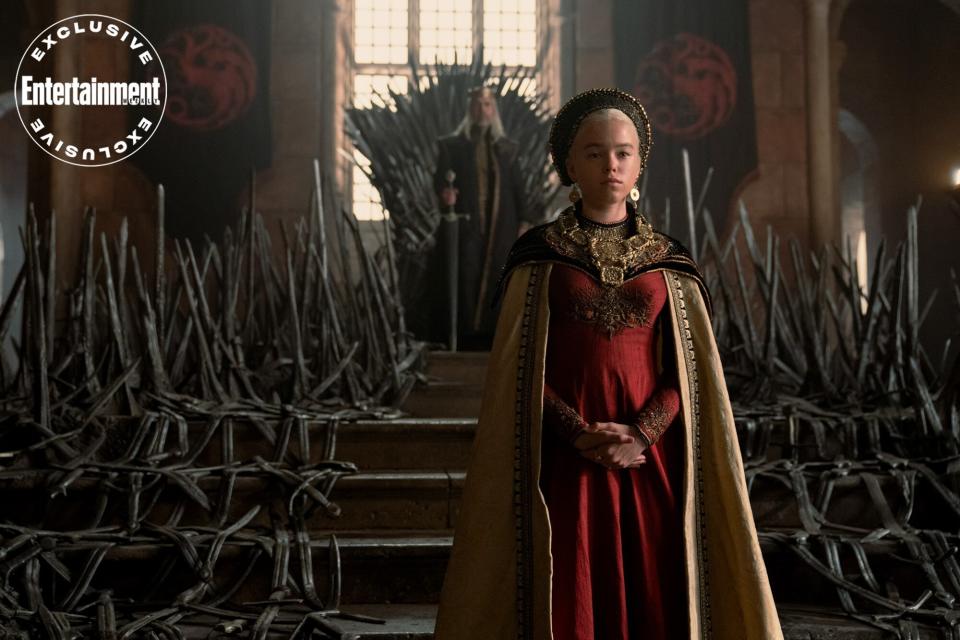House of the Dragon showrunners deconstruct the new Iron Throne design

- Oops!Something went wrong.Please try again later.
- Oops!Something went wrong.Please try again later.
The Iron Throne does not look like how Game of Thrones fans remember it.
The seat of power in Westeros, which became a visual staple of the Emmy-winning fantasy drama following its premiere in 2011, has been noticeably revamped for the first successor show, prequel House of the Dragon. As showrunners Ryan Condal and Miguel Sapochnik explain, it's partly to get a bit closer to how Game of Thrones creator George R.R. Martin described the throne in the books — which is still impractical when it comes to actually shooting the series.
"It was really fun to build that," Sapochnik, who directed some of the most widely praised episodes of Game of Thrones, tells EW from the spin-off's London set last December. "I've got to say, it's one of the most satisfying processes because there was no limit placed on how we did it. Rather, we designed it and then kind of worked backward."
Martin describes the Iron Throne in his novels as a hulking, asymmetric mass of twisted swords with a steep iron staircase leading to a seat from which the ruler could look down on everyone. Forged from the blades of Aegon Targaryen's defeated foes after he conquered Westeros, the structure is meant to be a symbol of conquest. There's nothing comfy about it.
"Originally, in the books, it's actually about 10-15 feet high," Sapochnik says. "We were designing [for House of the Dragon] and realizing, 'If we make it that high, we'll never shoot anybody up there to have an exchange.' You'll need a crane every single time." So they compromised: Warped melted swords ooze down the staircase on both sides of the chair with a pathway cleared for the actors — specifically Paddy Considine as King Viserys I Targaryen.

Ollie Upton/HBO Princess Rhaenyra Targaryen (Milly Alcock) is named the king's heir before the Iron Throne on 'House of the Dragon.'
The backward thinking also helped them explain the change within the context of the show itself. "If you look closely enough within that object, you will see the original object," Condal adds. Meaning the original Iron Throne design for Game of Thrones is still alive within the one for House of the Dragon. "We have not thrown out the original design, but instead augmented it."
Condal describes the era of House of the Dragon, set 200 years before the events of Game of Thrones, as a time of decadence at the height of Targaryen rule in Westeros. That is, before the events of the Dance of the Dragons, which was the civil war that crippled the once thriving dynasty. "When you see our throne, it immediately communicates this is a time of great influence and wealth for the people that built this thing," says the executive producer, who co-created House of the Dragon with Martin.
"The throne room was one of the most challenging things to build because it had to be different but it had to be the same," Sapochnik explains. "We were trying to figure out a way to tell the story of why there had not been any statues in the old show."
The actual reason, Condal says, was because Game of Thrones creators David Benioff and D.B. Weiss didn't want the set to feel dated. They also didn't have as many resources starting out as Condal and Sapochnik do now. But narratively speaking, to paraphrase Sapochnik, one event that occurs later in the history of Westeros is the sacking of King's Landing, which means a lot of stuff gets destroyed. To the showrunners, that's how the throne room goes from their version on House of the Dragon to the one seen during the events of Game of Thrones.
"Two-hundred years are about to happen between [House of the Dragon] and the thing that you saw originally," Condal says. "A lot of stuff happens in 200 years."
Learn more about House of the Dragon in EW's latest cover story. The series is set to premiere Aug. 21.
Related content:

